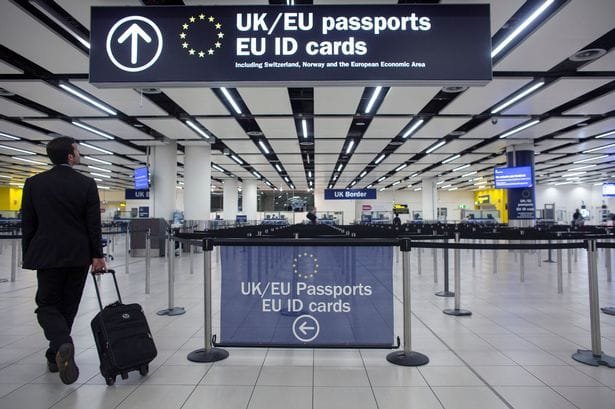
Travelers at an EU border using the new Entry/Exit System (EES) for faster digital checks.
EU Slowly Launches Digital Border System EU Border System EES
The European Union (EU) has launched its new digital border system today, October 12, 2025 This system is called the Entry/Exit System (EES) The EES will simplify border checks for non-EU citizens It will replace the old practice of stamping passports Digital records will now be maintained This change will enhance security and prevent illegal migration The EES will apply to 29 European countries These include 25 EU member states and Iceland, Liechtenstein, Norway, and Switzerland, all of which are part of the Schengen Area. People can travel within the Schengen Area without border checks, but strict checks are in place at external borders The EES will strengthen these.
History and Background of the EES
Planning for the EES began in 2016 The European Commission introduced it as part of the Smart Borders package The aim was to improve migration management The European Parliament and Council agreed on it in 2017 The law came into force on 29 December 2017 After several years of preparation, the EES is now underway The Commission proposed a slow rollout in 2024. Parliament and Council agreed in May 2025 In July 2025, Regulation EU 2025/1534 was adopted, which entered into force on 26 July 2025 The Commission set the launch date for 30 July 2025, but the system is part of the Security Union It supports the European Agenda on Security and the Migration Agenda Its main goals are to prevent terrorism and cross-border crime The EES will make it easier to detect overstayers Overstayers are those who overstay their permitted time
How the EES Works
The EES is an automated IT system that registers non-EU citizens traveling for short stays A short stay is up to 90 days out of 180. What happens upon entry? Travelers scan their passports Fingerprints and a facial image are taken for the first visit. Four fingerprints are taken For subsequent visits, a face scan alone is sufficient. If fingerprints are already in the system, the same process occurs upon exit. The system records the date of entry and exit, noting the location Entry refusals are also recorded This system supports automated border control gates Self-service kiosks will also be used This will speed up travel Travelers will be able to pass through comfortably, but the U-Lisa agency manages the system It handles major IT systems for freedom, security, and justice.
Rollout on schedule
The EES is rolling out slowly It will begin on October 12, 2025, and will be completed in six months Full implementation by April 10, 2026, which countries will decide Some will implement it completely, others gradually Data collection will be increased at border crossing points, making the transition easier and reducing queues European countries will implement EES at external borders, not internal borders According to Schengen rules and who EES affects, EES applies to non-EU citizens arriving for short stays Both visa-exempt and visa-required citizens of visa-exempt countries, such as the US, UK, Canada, and Australia, can stay for 90 days without a visa Now, citizens of visa-required countries, such as India and China, will be registered in EES.
They arrive with Schengen visas. EES will track their entry and exit, and will not apply to EU citizens Neither will citizens of non-Schengen EU countries, such as Ireland However, if they are non-EU citizens. it will be implemented because of special provisions for children and the elderly Fingerprints are not taken for children under 12 years of age. Optional for those over 70 years of age.
Data Collection and Privacy EU Border System EES
What data does the EES collect? Name, travel document data, biometrics Biometrics include fingerprints and facial images Date and place of entry and exit, and data on refusal of entry are stored for 3 years, and 5 years for overstayers Fundamental rights and data protection are respected However, there are concerns, including privacy concerns the risk of data leaks and hacking Flaws have been found in the software, putting millions of people’s data at risk A strong focus on non-EU citizens.
This appears to be discriminatory, and criticism has led to long queues and initial chaos. The travel industry is concerned Delays at airports and ports Privacy groups object The use of untested technology. Furthermore, the EES offers numerous benefits It quickly detects overstayers, prevents identity fraud, and reduces illegal migration, increasing security for those living and traveling in Europe Prevents cross-border crime and terrorism. Travel becomes easier Automated gates allow faster checks. Self-service systems are convenient. Passport stamping is eliminated. Digital records are reliable.
Challenges and Criticisms EU Border System EES
The EES faces criticism Privacy is the biggest concern Biometric data is stored Hackers could target it Flaws in EU border software Risk of data leaks, as well as delays in rollout. Long waiting times Chaos at entry points Politico warned, but the travel industry is affected Airlines and ferry operators are concerned All borders must be compliant within 180 days Face and fingerprints are stored and impact non-EU travelers They cannot refuse. Can Entry denied if refused Groups like Statewatch also raise concerns about digital privacy Data goes on a journey Untested technology as well as differences between EES and ETIAS ETIAS is the European Travel Information and Authorization System It will come in 2026 and ETIAS is pre-travel authorization For visa-exempt travelers. Apply online Pay the fee Database check Like the US ESTA, EES is registration at the border Entry-exit track Take biometrics For all non-EU short-stay travelers




